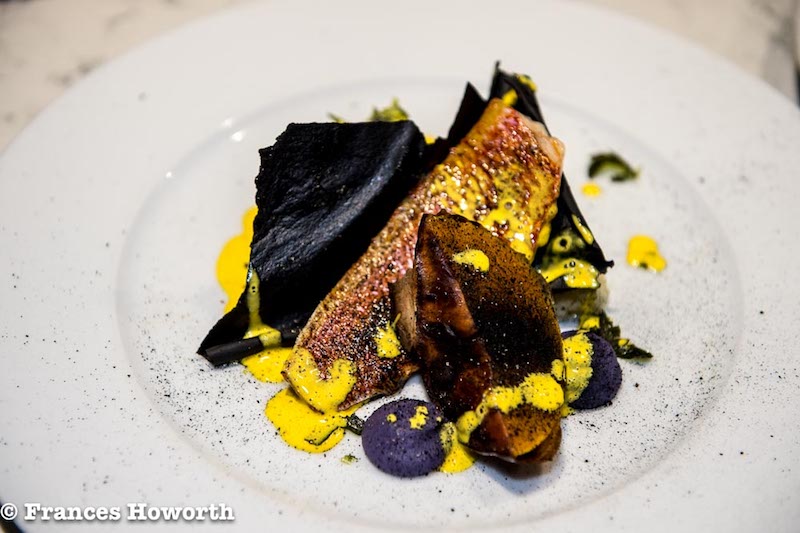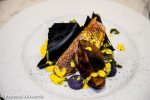Lisa Gerard-Sharp makes art of red mullet at a culinary Hogwarts in Reims

“Eat with your eyes – throw powder at it,” commands our culinary magician. In the shadow of Reims Cathedral we toss black volcanic dust on our Champagne dinner. It feels fabulously heretical and Harry Potterish.
Royal Reims, virtually obliterated during the Great War, is briefly reduced to dust again. Billed as black squid ink crunch, the powder crowns our concoction of red mullet in saffron sauce nestling in a purée of purple potato. Chef Eric loves Rothko, royal purple, Satanic black and culinary spells – preferably combined in witchy ways. Dazzled and a little drunk, we will never equate Champagne with conservative cuisine bourgeoise again.

It all began so innocently at our cookery school, Au Piano des Chefs. This creative cuisine experience is conducted by chef Eric Geoffroy, late of Rules restaurant in London, that bastion of Britishness. But as we nibble on chaource cheese and charcuterie we swiftly discover that rules in Reims are made to be broken. Our master chef is also a patissier and professional designer of Champagne bottles and kitchen furniture. In French philosophical style, Eric sees design and cooking as deeply interrelated, “It’s all about colour, texture and volume.” Inspired, we take a torch to the red mullet and its volume reduces instantly. Ebullient Eric, as bubbly as his bizarre creations, encourages us to sip Champagne as we work, including sampling small, biodynamic wines. We soon see ourselves as dynamic, free agents determining our human condition, challenging bourgeois thought and culinary conformity. Reinvigorated, we mash purple potato into pleasing volumes and reach for the naughty powder. Our careers as professional powder-tossers are launched.

All this culinary alchemy sets the tone for a Champagne-tasting tour that goes beyond the bubbles. We tootle off towards a mosaic of micro-vineyards around the Montagne de Reims, an upturned soup tureen of a hill between Reims and Chalons-en-Champagne. The featureless countryside can’t compete with the romance of most French wine regions – this is cool and collected Champagne, a distillation of northern France. The magic must lie in the bottle, we assume. Yet here, commanding a sea of vines, is a lighthouse, proof that personal folly can triumph over branding and balance sheets. Now turned into a Champagne museum, this Phare de Verzenay folly was built by a publicity-hungry grocer in 1909. While drinking in the vineyard views, we get to grips with the grapes, discovering how Pinot Noir adds the powerful backbone and body, Chardonnay brings fragrance and elegance while Meunier adds smoothness and fruitiness. We learn that Champagne is a cause for both celebration and resistance, with a “Champagne anti-Boches” produced here during the war.

At the foot of the lighthouse we fall into a family-run Champagne house in this Premier Cru village. Champagne Godmé embraces a marriage and a merger, with the owner’s father’s Pinot Noir estate bonding with her mother’s Chardonnay estate. Sabine Godmé stresses the importance of owning the vineyards, living the land, growing the grapes and making their own wine. Where the big brands buy in grapes and aim for consistency of style, the small guys are freer spirits. Sabine’s husband, Jean-Francois, describes how their children once hacked out their chalk cellars with pickaxes during the school holidays. Family slave labour isn’t dead in the Champers business. The estate Brut Blancs de Blancs suddenly tastes weightier, even if it goes down well with our light lunch of vegetable tart and boudin blanc. As Jean-Francois points out, “Champagne is not about potency but about delicacy and elegance.”
Instead, potency is paramount at Distillerie Guillon, a whisky-style distillery close to the aptly-named hamlet of Bouzy. In this former hunting lodge we sample fruity, smoky, peaty Spirits of Malt, including those downed at the Elysée Palace. Perhaps President Hollande finds more solace in spirits. Champagne is a barometer of French health and happiness – so a five percent fall in sales presumably doomed Francois Hollande’s presidency to fizzling out.
Mystery (and more Champagne) are back on the menu at Chalons-en-Champagne, a beguiling medieval cloth town that once wove Flanders to Northern France. An evening boat trip through the backwaters brings the medieval bastions to life. The electric boat slithers along the rivers Nau and Mau – there’s no Miaow despite the curled up cats along the riverbanks. A son et lumiere show illuminates fortified bridges and half-timbered mansions, casting shadows over spooky churches and twisted turrets. The Unesco-listed church of Notre-Dame-en-Vaux slips into view, leading pilgrims on to Santiago de Compostella long before Champagne existed to lure them back. From the waterfront, the Romanesque-Gothic church looks set to slip its moorings. Two long tunnels burrow under the city, one evoking mythical beasts and medieval pageantry, the other a psychedelic tribute to Champagne. We sail past sinister bridges and willow-hung meadows, startling ducks and flushing out grey herons in our eagerness to reach the next glass of bubbles in the city dubbed “sparkling Venice.”
Once ashore, we are greeted by a giant Champagne bottle that dominates the main square but our coven reconvenes in moody medieval wine cellars, chalky caverns made for secret rites rather than celebration. Champagne’s magic is often subterranean and subdued, at odds with the fizzy branding of the bigger bubbly producers. Champagne Lamiable’s dignified father-and-daughter team takes us through their bubbles, from the citrussy Extra Brut Grand Cru to the honeyed Cuvée Les Meslaines. Inexplicably, this vintage conjures up the vaulted cathedral’s stained glass windows, a drunken kaleidoscope of blues and reds which sends my head spinning. Cellar-masters compare the process of assemblage with the role of an artist choosing the right palette of colours so perhaps I’ve had less Champagne than I thought – or I’ve been hanging out with colourful creative chefs too long. Either way, the wisest advice on our magical mystery drinkathon is delivered by a cushion clutched by the sensible Sabine Godmé: Keep Calm and Drink Champagne. Save sobriety for regions with more modest wine.
Useful links:
Champagne-Ardennes Tourist Board
Cookery class: Au Piano des Chefs
Lighthouse: Phare de Verzenay, www.lepharedeverzenay.com
Champagne producers: Champagne Godmé Sabine, www.champagne-godme-sabine.fr
Distillery: Distillerie Guillon
Boat tour, Chalons: “Métamorph’eau’ses”
Restaurants Chalons: Les Caudalies & La Bourse
Hotel Le Pasteur, Chalons

